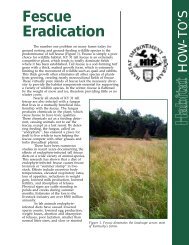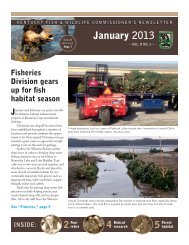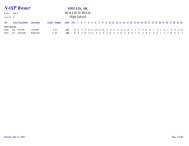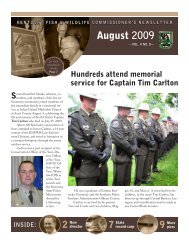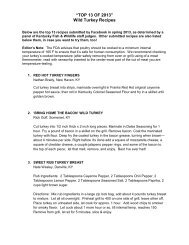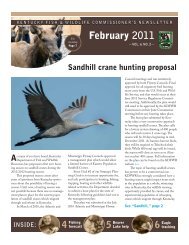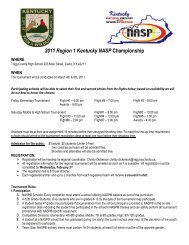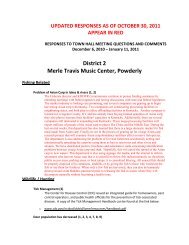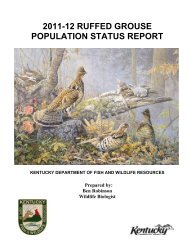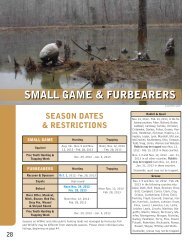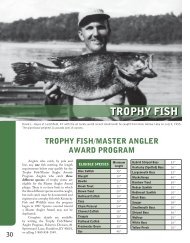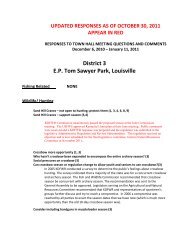hunting guide - Kentucky Department of Fish and Wildlife Resources
hunting guide - Kentucky Department of Fish and Wildlife Resources
hunting guide - Kentucky Department of Fish and Wildlife Resources
Create successful ePaper yourself
Turn your PDF publications into a flip-book with our unique Google optimized e-Paper software.
WILD TURKEY HUNTING<br />
4<br />
GOBBLER / HEN IDENTIFICATION<br />
WHITE CROWN<br />
MINOR CARUNCLES<br />
DARK PLUMAGE<br />
APPEARS TO BE BLACK<br />
STRUTTING<br />
GOBBLER<br />
VARIOUS REDS,<br />
WHITES & BLUES<br />
TURKEY HUNTING SAFETY TIPS<br />
1. Don’t stalk a turkey. The chances <strong>of</strong><br />
getting close enough for a shot are<br />
slim, <strong>and</strong> your chances <strong>of</strong> becoming<br />
involved in an accident increase.<br />
2. Eliminate the colors red, white <strong>and</strong><br />
blue from your turkey <strong>hunting</strong> outfit:<br />
t-shirts, socks, long underwear <strong>and</strong><br />
kerchiefs. Red or white are the colors<br />
hunters are looking for when differentiating<br />
a gobbler’s head from the<br />
hen’s grayish blue-colored head. These<br />
colors not only put you in danger, but<br />
they can be seen by turkeys as well.<br />
3. Don’t move, wave or make turkey<br />
sounds to alert another hunter <strong>of</strong> your<br />
presence. A quick movement may<br />
draw fire. Yell in a loud voice “Hey, I’m<br />
here,” <strong>and</strong> remain hidden.<br />
4. Be particularly careful when using a<br />
FEATHERED<br />
HEAD<br />
GRAY-BLUE<br />
COLOR<br />
GRAY-BROWN<br />
PLUMAGE<br />
SNOOD<br />
DEWLAP<br />
MAJOR<br />
CARUNCLES<br />
gobbler call. The sound <strong>and</strong> motion<br />
may attract other hunters, <strong>and</strong> could<br />
draw fire.<br />
5. When selecting your calling position,<br />
sit at the base <strong>of</strong> a large tree, if one<br />
is available, to protect your torso <strong>and</strong><br />
head. Position yourself so you can see<br />
180 degrees in front <strong>of</strong> you.<br />
6. Never shoot at a sound or movement.<br />
Be 100 percent sure <strong>of</strong> your target.<br />
Assume that every sound you hear is<br />
made by another hunter.<br />
7. When <strong>hunting</strong> with a turkey decoy,<br />
place the decoy about 20 yards from<br />
your calling position. To be safe you<br />
need a clear line <strong>of</strong> sight beyond the decoy<br />
<strong>of</strong> at least 80 yards. This will enable<br />
you to see any approaching hunter <strong>and</strong><br />
keep you at a safe distance if another<br />
hunter were to shoot at your decoy.<br />
GOBBLER<br />
The gobbler is most easily recognized by the<br />
long beard growing from his chest, <strong>and</strong> the<br />
pronounced spurs, sometimes as long as two<br />
inches, found on the back <strong>of</strong> his legs. A gobbler<br />
appears larger, darker, shinier <strong>and</strong> is more<br />
colorful than a hen, especially on his head,<br />
which can appear alternately red, white <strong>and</strong><br />
blue. He <strong>of</strong>ten “puffs up” <strong>and</strong> struts during<br />
spring to attract hens for breeding.<br />
SNOOD<br />
DEWLAP<br />
CARUNCLES<br />
HEN<br />
The hen’s overall look<br />
is for concealment <strong>and</strong><br />
protection. She is<br />
smaller <strong>and</strong> more drab<br />
than the colorful<br />
gobbler, so she can sit<br />
on her nest well<br />
camouflaged. Likewise,<br />
her head has more<br />
feathers to add to her<br />
camouflaged<br />
appearance.<br />
Based on information <strong>and</strong> graphics from the National Wild Turkey Federation website, which can be viewed at www.nwtf.org.<br />
8. Keep your shotgun unloaded when<br />
not in the field, <strong>and</strong> open the action or<br />
unload your shotgun when climbing<br />
a steep hill, stepping over low fence<br />
wire, or fording a creek.<br />
9. After bagging a turkey, put on an article<br />
<strong>of</strong> hunter orange while carrying<br />
the bird out <strong>of</strong> the woods.<br />
Register your turkey!<br />
For information about registering<br />
your turkey with the <strong>of</strong>ficial<br />
NWTF records system, log on to<br />
www.nwtf.org or contact National<br />
Wild Turkey Federation, Attn:<br />
Wild Turkey Records, P.O. Box<br />
530, Edgefield, SC 29824-0530,<br />
telephone: (803) 637-3106.



